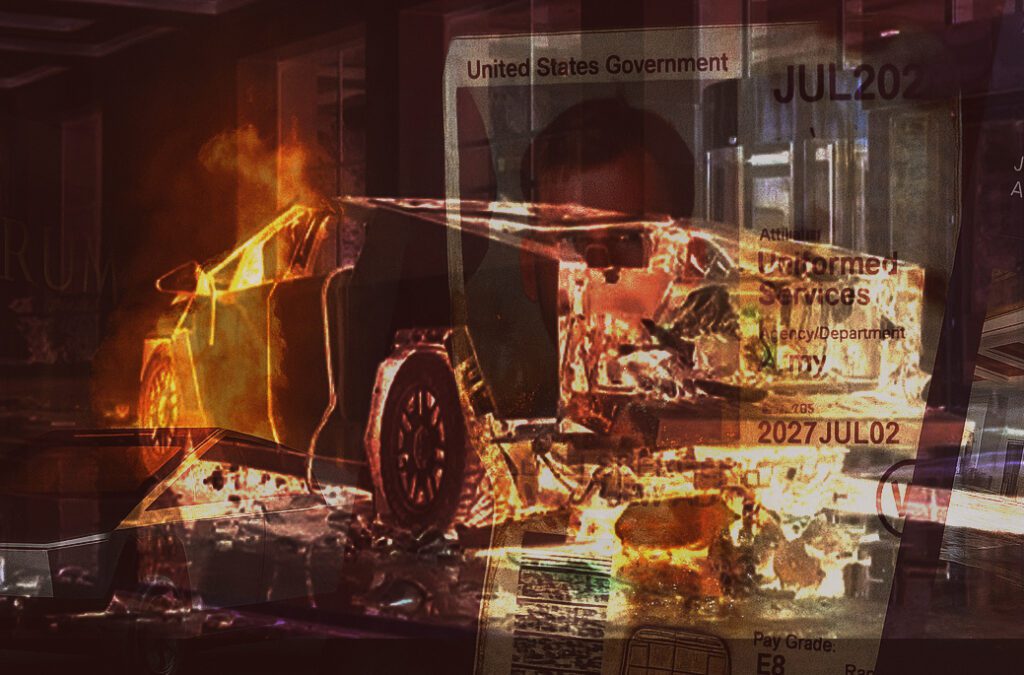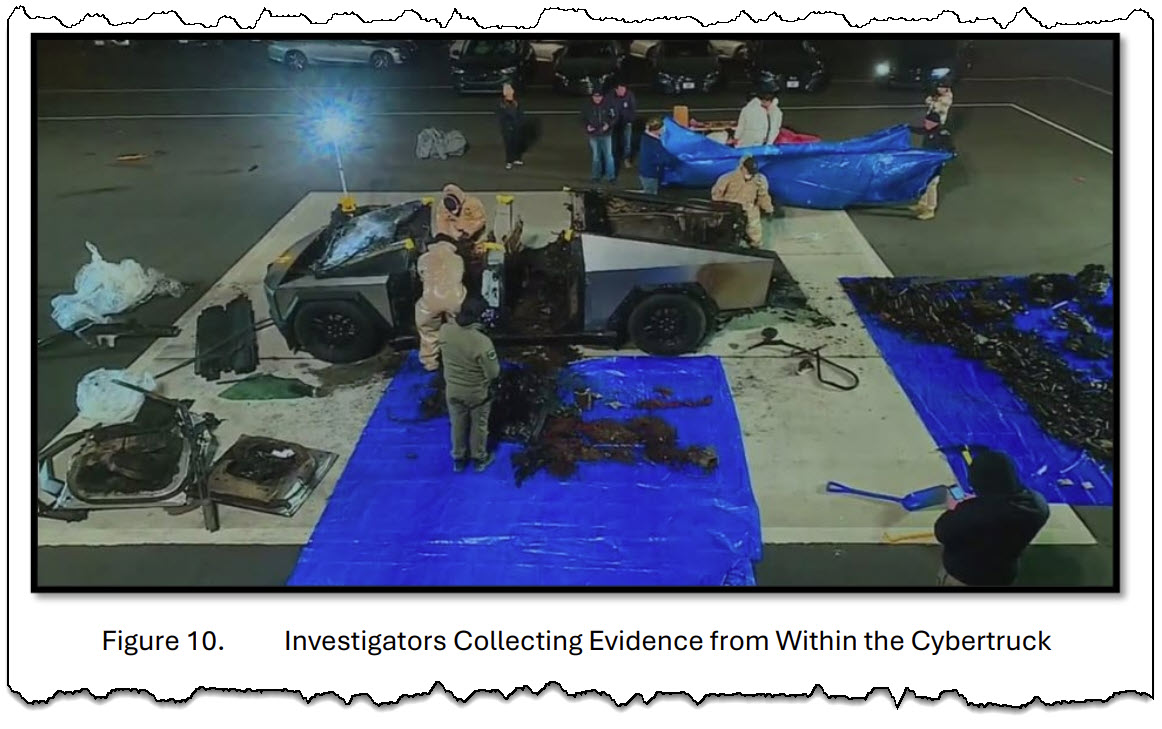 The Las Vegas Metropolitan Police Department has released its official after-action report on the January 1, 2025, Tesla Cybertruck explosion outside the Trump International Hotel Las Vegas. The 78-page document, published November 3, 2025, details the incident, the extensive local and federal response, and an unusual federal intervention that resulted in the suspect’s manifesto being classified by the Department of Defense.
The Las Vegas Metropolitan Police Department has released its official after-action report on the January 1, 2025, Tesla Cybertruck explosion outside the Trump International Hotel Las Vegas. The 78-page document, published November 3, 2025, details the incident, the extensive local and federal response, and an unusual federal intervention that resulted in the suspect’s manifesto being classified by the Department of Defense.
According to the report, Army Special Forces soldier Matthew Livelsberger deliberately drove a rented Tesla Cybertruck into the hotel’s porte cochere at approximately 8:40 a.m. and detonated it seconds later. The explosion killed Livelsberger and injured six others. The blast was determined to be a premeditated attack involving a vehicle-borne improvised explosive device capable of mass casualties and structural damage.
Investigators recovered firearms, ammunition, fuel containers, fireworks, and multiple electronic devices from the destroyed vehicle.
The LVMPD’s Digital Forensics Lab later extracted digital evidence including Livelsberger’s chat history, internet searches, encrypted notes, and a manifesto from one of two recovered iPhones. The report states that this material helped confirm the suspect acted alone but contained information that led the Department of Defense to classify the manifesto on January 9, 2025. The classification order ended LVMPD’s local investigation, transferring full control to federal authorities citing national security concerns.

Authorities and media outlets have reported the existence of an alleged manifesto linked to Livelsberger that may shed light on his motivations and state of mind in the days leading up to the explosion. According to information first published by the Shawn Ryan show, Livelsberger sent a lengthy email to a retired U.S. Army intelligence officer claiming to possess knowledge of secret government programs, classified drone technology, and alleged wartime misconduct. In the message, he described what he believed were “gravitic propulsion” aircraft, technology he attributed to both the United States and China, and referenced a “checkmate” scenario in which such craft could hover undetected over strategic targets. The email also included statements about covert military operations in Afghanistan, which Livelsberger claimed had resulted in civilian casualties that were later covered up. He wrote that he had been “followed for over a week” by intelligence agencies and suggested he was being digitally tracked.
The manifesto’s authenticity has not been verified by investigators, and its contents remain a subject of speculation. The Department of Defense has not publicly commented on whether the material it classified on January 9, 2025, matches the document published by Ryan. However, the overlap between the descriptions has fueled widespread discussion about whether the writings seized from Livelsberger’s devices and the email now circulating online are the same. If confirmed, the classification of the manifesto could suggest that elements of Livelsberger’s claims intersected with restricted or sensitive defense information, raising further questions about why the federal government moved swiftly to block public release of the document.
The sequence of events outlined in the report shows that Livelsberger rented the Cybertruck through the peer-to-peer car service Turo on December 28, 2024, after advancing the reservation from December 30. Surveillance footage later confirmed that, just before the explosion, Livelsberger was seen pouring an accelerant into the bed of the vehicle before driving it to the Trump hotel. Investigators verified that the Cybertruck’s internal cameras had been disabled manually prior to detonation.

Army Criminal Investigation Division agents assisted in executing search warrants at Livelsberger’s residences in Colorado and Germany, uncovering personal and service-related records. Interviews with his wife indicated marital and behavioral problems in the days before the incident, including erratic communication and financial isolation. Federal agents determined Livelsberger had purchased firearms, fireworks, and other materials in the days leading up to the attack.
The report documents a highly coordinated response between local, federal, and private-sector partners. Within minutes of the explosion, officers and firefighters evacuated the hotel, contained the fire, and established command posts. Specialized bomb technicians from the Las Vegas Fire Rescue Bomb Squad and the FBI confirmed the presence of fuel containers, fuses, and fireworks remnants. Drone footage and air-monitoring technology were used to assess the scene and ensure safety for investigators. The report cites this integration of drone technology as critical to “ensuring that personnel could advance only when it was deemed safe to do so.”
The LVMPD’s analysis also includes internal recommendations following the event. These include additional training on electric-vehicle battery hazards after several officers reported exposure symptoms from lithium-ion fumes, improved interagency communication protocols, and expanded protective equipment for crime-scene analysts. The report further calls for continued joint training between police and fire personnel to address differences in incident-command expectations during complex emergencies.
The Cybertruck was ultimately wrapped in a tarp and transported under escort to a secure LVMPD facility for examination. Once the Department of Defense intervened, LVMPD was directed to halt further public disclosure. Sheriff Kevin McMahill said that, despite significant media pressure to classify the attack as terrorism, investigators “prioritized a methodical and unbiased investigative approach” and refrained from public speculation until evidence could be verified.
The incident occurred just hours after a separate New Year’s Day terrorist attack in New Orleans that killed fourteen and injured fifty-seven. Though investigators found no connection between the two events, the timing amplified national security concerns. The LVMPD report concludes that Livelsberger acted alone but offers no explanation for the Department of Defense’s decision to classify his writings or what specific content warranted federal secrecy.
The release of the after-action report closes LVMPD’s portion of the case but leaves lingering questions about why the military assumed control, what was contained in Livelsberger’s manifesto, and whether any broader implications remain hidden behind classification.
###
Document Archive
 Loading...
Loading...Follow The Black Vault on Social Media:


